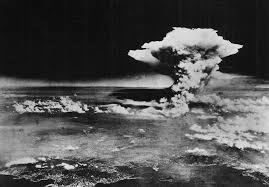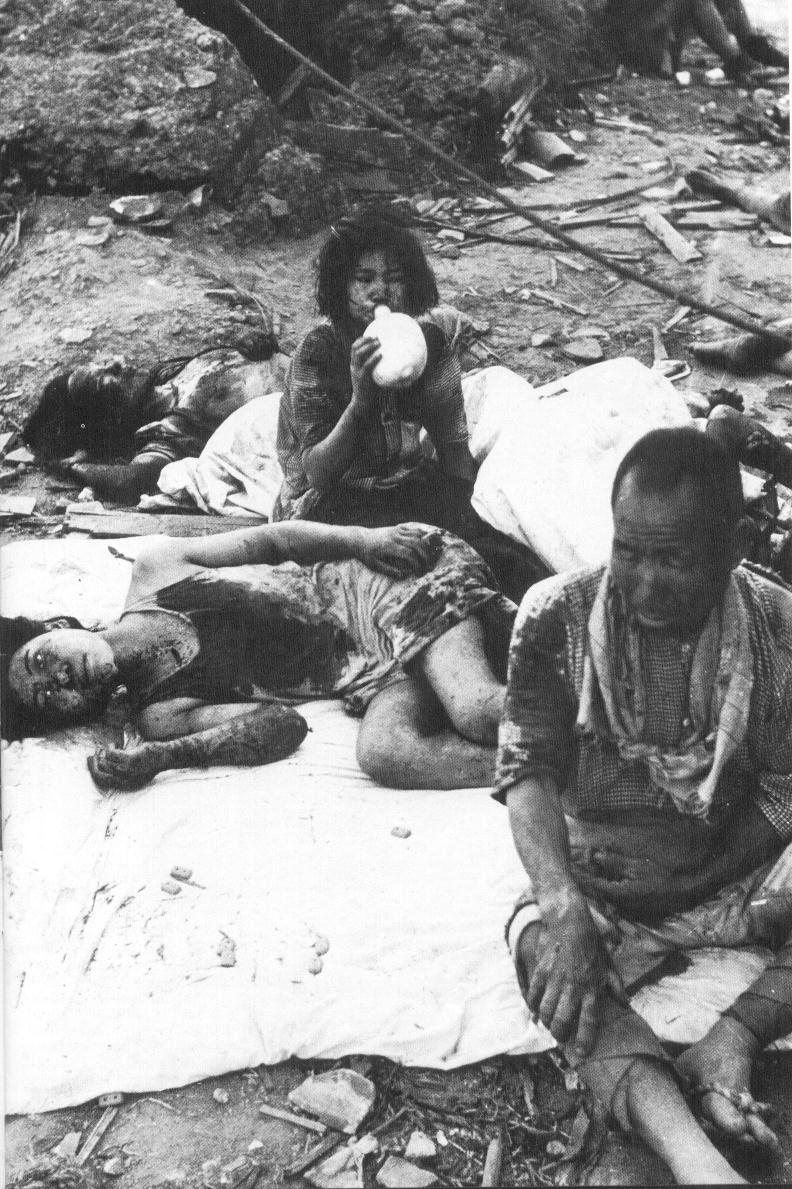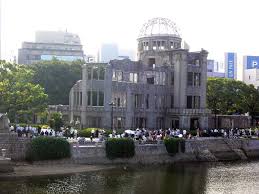Before the promised post on 'Slavery Part 3 - Morality is
Complicated' I have a compelling thought and so will take you on a
detour on the subject of building on top of bones.
I posted a little while ago a thought on cemetaries,; essentially that a cemetary is a good thing. It's a sign of a safe, well-resourced community where we have a dedicated place to celebrate the dead. Here is another story about a cemetary; symbolically far less safe but utterly dedicated.
Members of my family have just come back from Hiroshima, and they brought back stories.
It would give me great honour to take you on a virtual stroll through two particular cemetaries in Hiroshima.
On the 6th of August, 1945, a uranium bomb with a yield of 16 kilotons was dropped and detonated at an altitude of 600m, just to the east of the T-bridge in the central city.

There are green spaces in the middle of the modern city, marked Hiroshima Peace Memorial Park and Central Park. You might guess that this is because it was previously reduced to rubble. You would be wrong.
In the <1km range, rubble is not an accurate description. There was a melted-matter slurry, where wood and stone and ceramic was fused with human flesh and clothing and hair. In the Hiroshima Museum, there are pieces of this slurry.
There were some survivors - for a little while. Burns were horrific, skin peeled off in ribbons. Often their clothes and posessions were fused to their bodies, and their hair had melted. Some were caught in the wreckage. Fires took hold very quickly and everyone who could leave, did so.

 In
the 2-5km range, most structures survived but city infrastructure (eg.
sewage, food, fresh water, roads) collapsed. Systemic radiation
illnesses abounded. Survivors suffered a high incidence of leukemia,
thyroid illness (cancer and autoimmune), A-bomb cataracts, other cancers
(breast, lungs, salivary glands), high incidence of infertility for
pubescent girls at the time of the blast, high incidence of birth
defects, including mental retardation, for women pregnant at the time
of, or in the year following the blast, plus, of course, disfiguring
keloid scars.
In
the 2-5km range, most structures survived but city infrastructure (eg.
sewage, food, fresh water, roads) collapsed. Systemic radiation
illnesses abounded. Survivors suffered a high incidence of leukemia,
thyroid illness (cancer and autoimmune), A-bomb cataracts, other cancers
(breast, lungs, salivary glands), high incidence of infertility for
pubescent girls at the time of the blast, high incidence of birth
defects, including mental retardation, for women pregnant at the time
of, or in the year following the blast, plus, of course, disfiguring
keloid scars.
Total casualty estimates are hard to determine. The Peace Park lists 130,000 dead in the blast, or wounded to die during the following week, and 50,000 dead over time as a consequence of injuries or illness from the blast. This is not a clean number. Deaths from cancer, thyroid and autoimmune disease throughout the last 50 years are measured higher in the Hiroshima area - but bomb survivors sometimes live into their 80's and 90's. And how do you count the effect of trauma, depression and PTSD, in a culture in which honourable suicide is not traditionally a problem?
Neither Hiroshima nor Nagasaki has elevated background radiation. The blast was airborne, so most of the remaining radioactive isotopes dissipated into the fallout and the atmosphere quite quickly. and surface contamination turned out to be minor. Additionally, many of the residual radioactivse isotopes had very short half-lives, decaying quickly. Current Hiroshima and Nagasaki hospitals have the same levels of radiation-related illness as the rest of Japan, and most of the world.
Bomb survivors (called Hibakusha) still suffer discrimination because of their disfigurement, and cruel rumours of contagious illness or inherited mutations. Children of Hibakusha can also be victims of discrimination. The Hibakusha are much older now, but they still actively and vociferously campaign against nuclear proliferation, and for stronger anti-discrimination legislation. Every year on the anniversaries of the Bombs, those Hibakusha who died during the last year have their names added to the books of the Hiroshima and Nagasaki dead.
 The dome was famously left standing because it was directly under the blast and missed the destructive horizontal shockwave - it has been conserved, but not restored. Mature trees were
transplanted into the centre of the city during reconstruction, and this was
pioneering horticulture at the time. The central city is now green and
modern; people go to work and fret about romance and eat lunch and laugh
about the latest internet meme the way we do in every other city - but with
possibly a hundred thousand ghosts in the soil under their feet.
The dome was famously left standing because it was directly under the blast and missed the destructive horizontal shockwave - it has been conserved, but not restored. Mature trees were
transplanted into the centre of the city during reconstruction, and this was
pioneering horticulture at the time. The central city is now green and
modern; people go to work and fret about romance and eat lunch and laugh
about the latest internet meme the way we do in every other city - but with
possibly a hundred thousand ghosts in the soil under their feet.
When Mother Teresa visited the Peace Park in 1984, apparently she took her shoes off on arrival and walked barefoot, explaining to her entourage that she was walking on holy ground.
There are shrines and sculptures and memorials right through the Peace Park. In the Peace Museum, you can read messages from people who survived the Bomb, and people who visited the memorial.
The iconic photographs are of the memorial dome, the singed but intact watch stopped at 8:15AM, the child's bicycle, and the poem about the dragonfly:



but this one also touched me: the shadow of a person on a step from near the blast. This person left no body - just a few million atoms pressure-sprayed into the rock, as the rest vaporised.



I posted a little while ago a thought on cemetaries,; essentially that a cemetary is a good thing. It's a sign of a safe, well-resourced community where we have a dedicated place to celebrate the dead. Here is another story about a cemetary; symbolically far less safe but utterly dedicated.
Members of my family have just come back from Hiroshima, and they brought back stories.
It would give me great honour to take you on a virtual stroll through two particular cemetaries in Hiroshima.
On the 6th of August, 1945, a uranium bomb with a yield of 16 kilotons was dropped and detonated at an altitude of 600m, just to the east of the T-bridge in the central city.
Here is a blast map from 1945, sourced from here.
Here is a modern Google map of central Hiroshima.
There are green spaces in the middle of the modern city, marked Hiroshima Peace Memorial Park and Central Park. You might guess that this is because it was previously reduced to rubble. You would be wrong.
In the <1km range, rubble is not an accurate description. There was a melted-matter slurry, where wood and stone and ceramic was fused with human flesh and clothing and hair. In the Hiroshima Museum, there are pieces of this slurry.
There were some survivors - for a little while. Burns were horrific, skin peeled off in ribbons. Often their clothes and posessions were fused to their bodies, and their hair had melted. Some were caught in the wreckage. Fires took hold very quickly and everyone who could leave, did so.

In
the first few weeks there were few photographers, and very few
non-Japanese witnesses or aid workers in the first two weeks. Later,
some drew pictures. I am not easily disturbed but this is distubring. I
am holding my breath as I am typing this, having found and read the stories under these pictures. You will notice I haven't included the pictures here. You can decide to follow the link, or not, for yourself.
Makeshift hospitals were set up at various places in the city. American military doctors arrived with orders to take notes on the effect of radiation sickness for military research - because it was presumably interesting to the CIA, and there was not much else they could do for the victims. Shinto burial is traditionally done by cremation, but this quickly became impossible. Corpses were stacked in the area of the Peace Park, and at various places throughout the city - quantities of human bones and skulls are periodically found, even very recently.
Makeshift hospitals were set up at various places in the city. American military doctors arrived with orders to take notes on the effect of radiation sickness for military research - because it was presumably interesting to the CIA, and there was not much else they could do for the victims. Shinto burial is traditionally done by cremation, but this quickly became impossible. Corpses were stacked in the area of the Peace Park, and at various places throughout the city - quantities of human bones and skulls are periodically found, even very recently.
Total casualty estimates are hard to determine. The Peace Park lists 130,000 dead in the blast, or wounded to die during the following week, and 50,000 dead over time as a consequence of injuries or illness from the blast. This is not a clean number. Deaths from cancer, thyroid and autoimmune disease throughout the last 50 years are measured higher in the Hiroshima area - but bomb survivors sometimes live into their 80's and 90's. And how do you count the effect of trauma, depression and PTSD, in a culture in which honourable suicide is not traditionally a problem?
Neither Hiroshima nor Nagasaki has elevated background radiation. The blast was airborne, so most of the remaining radioactive isotopes dissipated into the fallout and the atmosphere quite quickly. and surface contamination turned out to be minor. Additionally, many of the residual radioactivse isotopes had very short half-lives, decaying quickly. Current Hiroshima and Nagasaki hospitals have the same levels of radiation-related illness as the rest of Japan, and most of the world.
Bomb survivors (called Hibakusha) still suffer discrimination because of their disfigurement, and cruel rumours of contagious illness or inherited mutations. Children of Hibakusha can also be victims of discrimination. The Hibakusha are much older now, but they still actively and vociferously campaign against nuclear proliferation, and for stronger anti-discrimination legislation. Every year on the anniversaries of the Bombs, those Hibakusha who died during the last year have their names added to the books of the Hiroshima and Nagasaki dead.
| Hiroshima survivor Sumiteru Taniguchi in 2004 |
Memorial Spaces in the Central City
The Peace Park and the Central Park were created by bringing in large quantities of soil to bury the smelted remains of the city.When Mother Teresa visited the Peace Park in 1984, apparently she took her shoes off on arrival and walked barefoot, explaining to her entourage that she was walking on holy ground.
There are shrines and sculptures and memorials right through the Peace Park. In the Peace Museum, you can read messages from people who survived the Bomb, and people who visited the memorial.
The iconic photographs are of the memorial dome, the singed but intact watch stopped at 8:15AM, the child's bicycle, and the poem about the dragonfly:


but this one also touched me: the shadow of a person on a step from near the blast. This person left no body - just a few million atoms pressure-sprayed into the rock, as the rest vaporised.
Green spaces outside the blast zone
So
after the intense experience of the Peace Park and Museum, my family
retreated to the serenity of the Shukki-En Garden. The pictures
apparently don't capture the living energy of this place. They sat under
a tree, breathed the clean air, and watched the koi.
The
guide then explained that in the weeks after the bomb, 20,000 people -
severe burn and radiation victims - had also retreated up here, carrying
family members and the bodies of their children, or looking for their
children - because clean water was still available up here and it was a
serene place to die. Nobody removed the corpses. Their bones are still
here, under the younger trees and the lawn.

Names are Often Recorded in the Cemetary.
There are books of names.
On
the day my family was there, a memorial ceremony was being conducted.
One man and two women were kneeling on the step of one of the memorials,
methodically and silently turning the pages of books in the measured
graceful style of the Japanese. There were about 150 books, bound in patterned paper, of around 500 pages each. Each page was crowded with names written in Kanji. A bank of schoolchildren and a few bystanders were sitting and watching
The
guide explained that this was the list of the known dead - those
missing or dead in the blast, those dead from radiation sickness, and
each year the long-tem survivors who died from any cause of death are
added to the list too. Each name sees the light and the air once a
year. The names were not read aloud. Turning the pages takes three
people most of the day.




